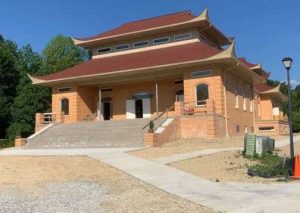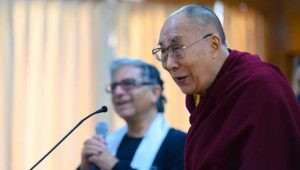When Siddhattha Gotama some 2,500 years ago left his home, a palatial residence in northern India, seeking enlightenment, it is likely he never dreamed that the religion he founded would have a presence in present day Loudoun County.
Gotama’s odyssey toward enlightenment led him into a period of self deprivation and finally to the belief that the best road through life was the middle one – neither vast wealth nor denying oneself the essentials of life.
Buddhism spread all over Asia and eventually the world. Thailand is 90 percent Buddhist, a Sanskrit word that means enlightenment. Early every morning in Bangkok you will see figures walking the streets in orange saffron robes, shaven heads, clutching metal vessels known as beggar bowls. Merchants and individuals have set food out on tables and the monks pause to gather their morning meal. Every Thai male is expected to spend at least two weeks in a monastery.
I recently met with Abbot Udom, originally from Chiang Mai in Northern Thailand, dressed accordingly, at Wat Yarma Rangsee off Shaw Road in Sterling. Wat is the Thai name for temple, and the Yarma Rangsee is a combination of ‘knowledge and rain’. Udom says there are three Wats in Virginia serving followers of Buddha in Virginia and Maryland.
Udom, who has been a monk for 35 years, says, “I like the location here for Thai people and all nations to come as we are close to Dulles Airport.”
There are five monks in residence at the monastery next to the Wat, which was built in 2009 by virtue of donations from adherents to Buddhism at a total cost of $1.5 million. The monastery has been there since the mid-1990s. The Wat serves about 2,000 people, according to Udom, with 700 regulars who may come to the Wat in the morning to pay their respects to the Buddha whose image dominates the inside of the Wat in the form of a statue.
Udom explained that the image is one of meditation although there are a number of variations of Buddha in different poses. All of them were shipped here from Thailand as was the giant cymbal used to call the monks to meditation.
Udom began to rub the middle of the cymbal with his right hand and soon we could hear a haunting hum that grew louder and louder. He bade me to try it and after a minute or two I gave up – no sound. Then he told me to pick up the drumstick and strike the cymbal.
As in most religions there are different forms of Buddhism. The one prevalent in Thailand is known as Thammayut and dates to King Rama IV of the early 1800s. According to Udom, King Rama IV, who incidentally was the young prince in the musical and the movie “The King and I,” felt that, “monks were weak and he joined a monastery for a period of time.”
He put the power of the throne behind this form of Buddhism and ‘strengthened’ the stature of the monks.
People bring sufficient prepared food to accommodate the five monks. They have no cook as Udom says, “We only have to warm the food.”
A young monk named Annex told me that their typical day consists of rising early and chanting the teachings of Buddha, followed by meditation and then cleaning up their quarters and the Wat. At 11 a.m. they have lunch and after that, he said, usually people come to them for discussion. Then from 8 to 9 p.m. more meditations before turning in for the day.
As I was getting ready to leave, a young man named Suhaf brought a bag of food, and Udom tied a length of yarn around his wrist while saying a few words as if a prayer. Annex told me it was a blessing. The next thing I knew Udom had tied yarn around my wrist and spoke some words in Thai.
A short time later I thanked my hosts (Khob koon mak krop) and bid them goodbye (Sawat dee krop). Udom smiled and said, “Come back anytime.” Annex echoed, “Anytime.”










